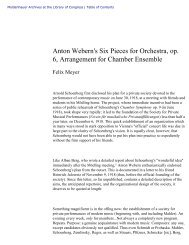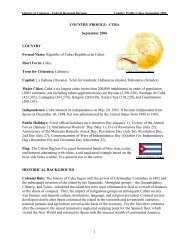- Page 1 and 2:
SLAVE NARRATIVES A Folk History of
- Page 3 and 4:
INFORMANTS Quinn, Doc 1, ,5,7,8 She
- Page 5 and 6:
0 0---3 OP Texarkana District O k^
- Page 7 and 8:
#3 .:■ 3 And another time I wuz w
- Page 9 and 10:
,'.30893 gOUSLQHB SUBJECTS Name of
- Page 11 and 12:
(bOr & ^ t / - « - FOLKLORE 3IBJ3C
- Page 13 and 14:
I 'member one time tho* when he cha
- Page 15 and 16:
tr The owners was tryin 1 to hide t
- Page 17 and 18:
I was fifteen years old vixen we co
- Page 19 and 20:
»Our white folks took us to Texas
- Page 21 and 22:
Interviewer Miss Irene Robertson Pe
- Page 23 and 24:
"Mother said I had three older brot
- Page 25 and 26:
Interviewer Mrs* Bernice Bowden Per
- Page 27 and 28:
—^u ^O Interviewer Mrs* Bernice B
- Page 29 and 30:
Mother "My mother was born a Goodma
- Page 31 and 32:
«
- Page 33 and 34:
"One old log house there used to be
- Page 35 and 36:
"We were savages when we came over
- Page 37 and 38:
In aftermath of Beeves 1 story is f
- Page 39 and 40:
tell my mother. A girl I was raised
- Page 41 and 42:
n lity mother used to tell me how t
- Page 43 and 44:
"Younger generation ain f t near li
- Page 45 and 46:
"We chillun had nothing to do wid c
- Page 47 and 48:
30806 Interviewer Miss Irene Robert
- Page 49 and 50:
"'Ihey kept hounds* Colonel Radford
- Page 51 and 52:
Freedom ♦•The soldiers come and
- Page 53 and 54:
y herself in a house on the place*
- Page 55 and 56:
"The Ku Klux never pestered us* I h
- Page 57 and 58:
n I been farmin* all my life till I
- Page 59 and 60:
30515 Interviewer Miss Irene Robert
- Page 61 and 62:
'l Visited by P&ther b^ ••When
- Page 63 and 64:
Later, it changed its name to the M
- Page 65 and 66:
Interviewer Miss Irene Robertson Pe
- Page 67 and 68:
Another teacher entered the room, N
- Page 69 and 70:
»|fhere was I horn, ma*am ? Why it
- Page 71 and 72:
T oft Robinson $ how I felt. »You
- Page 73 and 74:
Tom Robinson 8 gg \\ It was awful h
- Page 75 and 76:
i,y ) Interviewer Miss Irene Robert
- Page 77 and 78:
n It wouldn't do no more good to vo
- Page 79 and 80:
She say some nights when they campe
- Page 81 and 82:
Interviewer Miss Irene Robertson Pe
- Page 83 and 84:
He was the only one kept the box«
- Page 85 and 86:
50635 #680 gg Interviewer Samuel S*
- Page 87 and 88:
My cousin was the one had to go out
- Page 89 and 90:
Family "I am the mother of fifteen
- Page 91 and 92:
30502 80 Interviewer Miss Irene Rob
- Page 93 and 94:
V w ."! 80882 FOLKLORE SUBJECTS NAM
- Page 95 and 96:
! 30461 Interviewer Miss Irene Robe
- Page 97 and 98:
.50 92 Interviewer Mrs* Bernice Bow
- Page 99 and 100:
Interviewer Samuel S» Taylor Perso
- Page 101 and 102:
Her husband is dead. We had ten chi
- Page 103 and 104:
-2- the war. I know I must have "be
- Page 105 and 106:
theirselves. They didn't have "butt
- Page 107 and 108:
-6- Wood pressure keeps me from rem
- Page 109 and 110:
"My mother was a field hand in busy
- Page 111 and 112:
"They had a battle at Lawrence ♦
- Page 113 and 114:
"I never seen times like this* Sin
- Page 115 and 116:
from all over de country* Of course
- Page 117 and 118:
"After my father bought his own far
- Page 119 and 120:
STATE— Arkansas NAiE OF WORKER—
- Page 121 and 122:
■*• 11G 9c * ? him in the Missi
- Page 123 and 124:
J(:3i9 118 Interviewer Mary p* Hudf
- Page 125 and 126:
Emma Sanderson Hudglns 120 and chai
- Page 127 and 128:
g Emma Sanderson H^dgins 12*3 The f
- Page 129 and 130:
30430 .^ 124 Interviewer Mima Irene
- Page 131 and 132:
3. me a month with her and doctored
- Page 133 and 134:
.'•■ ■ :i f Tnterviewer Miss
- Page 135 and 136:
"I seen a whole gang of Ku KLuxes h
- Page 137 and 138:
Usually take about eight and ten in
- Page 139 and 140:
,-0487 & I'M Interviewer Miss Irene
- Page 141 and 142:
STATE—" Arkansas NiJS OF WORKER
- Page 143 and 144:
Interviewer: 1 s Comment This woman
- Page 145 and 146:
;.i0135 Interviewer Miss Irene Hobe
- Page 147 and 148:
*I ain't never been to school much*
- Page 149 and 150:
and set out playing* Some got in th
- Page 151 and 152:
Dis nigger dropped in his tracks la
- Page 153 and 154:
30648 #718 148 Form A - Circumstanc
- Page 155 and 156:
ferfc of Interview (Unedited} #718
- Page 157 and 158:
"She was sick only one week and the
- Page 159 and 160:
■#J* 30760 154 Interviewer Miss I
- Page 161 and 162:
fney would go to the woods if he be
- Page 163 and 164:
They took his horse and he finally
- Page 165 and 166:
Interviewer Miss Irene Robertson Pe
- Page 167 and 168:
during the War* Once the soldiers c
- Page 169 and 170:
"My master put good clothes on me*
- Page 171 and 172:
0 ; V/ V.X «..>■ *..*.' 166 Inte
- Page 173 and 174:
"I was my raama f s seventh girl, a
- Page 175 and 176:
30824 Interviewer. Miss lEgjne Robe
- Page 177 and 178:
FOLKLORE SUBJECTS JTame of Intervie
- Page 179 and 180:
30801 Interviewer Miss Irene Robert
- Page 181 and 182:
STATS— Arkansas KA1.1E OF W03KEB
- Page 183 and 184:
ST-iIE—Arkansas ffAI'2 OF W0BK2B
- Page 185 and 186:
:ioxm 180 Interviewer Thomas Blmore
- Page 187 and 188:
Interviewer Pernella Anderson Perso
- Page 189 and 190:
They taught me to do carpenter work
- Page 191 and 192:
1 Bow do they live? Some of their w
- Page 193 and 194:
"I am told that the old fellow boug
- Page 195 and 196:
First Pair of Shoes "I can remember
- Page 197 and 198:
30813 92 Interviewer Mrs. Bernice B
- Page 199 and 200:
She was part Indian—^better work
- Page 201 and 202:
Interviewer Mrs* Beraice Bowden Per
- Page 203 and 204:
30780 Interviewer Samuel S» Taylor
- Page 205 and 206:
uilded on to the end of ito The log
- Page 207 and 208:
Marriage "I married in 1879* My fat
- Page 209 and 210:
*I went to school after the war wha
- Page 211 and 212:
"Papa said the Yankees made all the
- Page 213 and 214:
«JK>* : "~4U Interviewer Miss Iren
- Page 215 and 216:
Iflhat I do wid ray money I made? I
- Page 217 and 218:
Interviewer Mrs* Bernice Bowden Per
- Page 219 and 220:
Interviewer . Mrs* Bernice Bowden P
- Page 221 and 222:
80459 a 6 Interviewer Miss Irene Ro
- Page 223 and 224:
*• 30759 f Interviewer Miss Irene
- Page 225 and 226:
30751 • c8? Interviewer Mrs* Bern
- Page 227 and 228:
30467 ooo Interviewer Miss Irene Ro
- Page 229 and 230:
fore the darkies and turning them l
- Page 231 and 232:
^ 30313 Interviewer Beulah Sherwood
- Page 233 and 234:
There have always been separate sch
- Page 235 and 236:
had been accustomed to enjoy. I rem
- Page 237 and 238:
I do not like the trend of amusemen
- Page 239 and 240:
30761 Interviewer Miss Irene Robert
- Page 241 and 242:
oO(>^0 #761 Interviewer Samuel S»
- Page 243 and 244:
k&i 938 Interviewer Miss Irene Robe
- Page 245 and 246:
Old man Simpson sent for my father
- Page 247 and 248:
My stepmother carried me over to Br
- Page 249 and 250:
Opinions *I can't say much along th
- Page 251 and 252:
Ou >uo^6 #68i 246 Interviewer Samue
- Page 253 and 254:
Soldiers "My father said once that
- Page 255 and 256:
and all the men were off that day b
- Page 257 and 258:
30832 Interviewer Miss Irene Bobert
- Page 259 and 260:
30769 ^ ' 254 u K Interviewer Miss
- Page 261 and 262:
'The Old Time Religion 1 is the onl
- Page 263 and 264:
Ihey said they might steal me* Afte
- Page 265 and 266:
"Old man Bullocks had about eight o
- Page 267 and 268:
You never saw how much cotton was g
- Page 269 and 270:
they would steal anything they want
- Page 271 and 272:
Interviewer Miss Irene Robertson Pe
- Page 273 and 274:
"It is so about the pigeons at Pige
- Page 275 and 276:
n I f ve always done farmin 1 . Tha
- Page 277 and 278:
"The day they fit on Stone River in
- Page 279 and 280:
Good Masters *The Adamses were good
- Page 281 and 282:
ior the Pacific Express Company und
- Page 283 and 284:
"Henry Powell was jailer here once.
- Page 285 and 286:
30K07 Interviewer Miss Irene Robert
- Page 287 and 288:
30508 ~° w Interviewer Miss Irene
- Page 289 and 290:
quit. Both them soon livin' wid som
- Page 291 and 292:
"I don 9 t know nuthin v f bout the
- Page 293 and 294:
Some woman out here in Arkansas rec
- Page 295 and 296:
The riding boss would come round ab
- Page 297 and 298:
so that everything would be ready w
- Page 299 and 300:
"I married the second year I came t
- Page 301 and 302:
Interviewer Mrs* Berniee Bowden Per
- Page 303 and 304:
and we never did get nothin'* USy f
- Page 305 and 306:
y V 30U9: Interviewer Sanaa! 8. Tay
- Page 307 and 308:
She would make them by hand because
- Page 309 and 310:
30749 A % \ Interviewer Mrs* Bernic
- Page 311 and 312:
0758 Interviewer Miss Irene Roberts
- Page 313 and 314:
I can see big changes taking place
- Page 315 and 316:
"My mother f s name was Susanna Bri
- Page 317 and 318: and they got out and went on their
- Page 319 and 320: Personal Occupations *I used to wor
- Page 321 and 322: "When I was a child, patching and d
- Page 323 and 324: 0421 til8 Interviewer Miss Irene Ro
- Page 325 and 326: ."30890 33 Interviewer Miss Irene
- Page 327 and 328: Itofcerviewer »Samael S* Ufaylor P
- Page 329 and 330: Early Days n I was little nhen my m
- Page 331 and 332: Batrollers n Me and old lady Eford
- Page 333 and 334: and she told me to go on to my moth
- Page 335 and 336: 3007 Ovr+rs, Ark. OH) SLAVE STORIES
- Page 337 and 338: \* ? People talk bout dis garablin
- Page 339 and 340: OZ> t{ I ''>..
- Page 341 and 342: 80656 Interviewer Samuel S* Taylor
- Page 343 and 344: We was from Sunday night to Sunday
- Page 345 and 346: I don*t reckon pa would ever have r
- Page 347 and 348: and a mule* "Who was go in* to give
- Page 349 and 350: and he was dead for twenty-five min
- Page 351 and 352: LJ- J.. 81)639 346 Interviewer S. S
- Page 353 and 354: "There was a colored man there that
- Page 355 and 356: for the field. They didn't allow th
- Page 357 and 358: 7 " 352 back several times and trie
- Page 359 and 360: El Dorado District oUOvi4 FOLKLORE
- Page 361 and 362: Unole James Tubbs. ^^U Fokes would
- Page 363 and 364: •The Yankees had their headquarte
- Page 365 and 366: 30819 Interviewer Mrs# Bernice Bowd
- Page 367: *Younger generation? Now you done a
- Page 371 and 372: made of the same material as an old
- Page 373 and 374: of Nat Turner, Dick Berry, and Milt
- Page 375 and 376: Seabe Tuttle -2~ *We found us a cab



![Albert Einstein Papers [finding aid]. Library of Congress. [PDF ...](https://img.yumpu.com/21604228/1/190x245/albert-einstein-papers-finding-aid-library-of-congress-pdf-.jpg?quality=85)





![American Colony in Jerusalem Collection [finding aid]. Library of ...](https://img.yumpu.com/17941275/1/190x245/american-colony-in-jerusalem-collection-finding-aid-library-of-.jpg?quality=85)



![Piccard Family Papers [finding aid]. - American Memory - Library of ...](https://img.yumpu.com/17941234/1/190x245/piccard-family-papers-finding-aid-american-memory-library-of-.jpg?quality=85)


